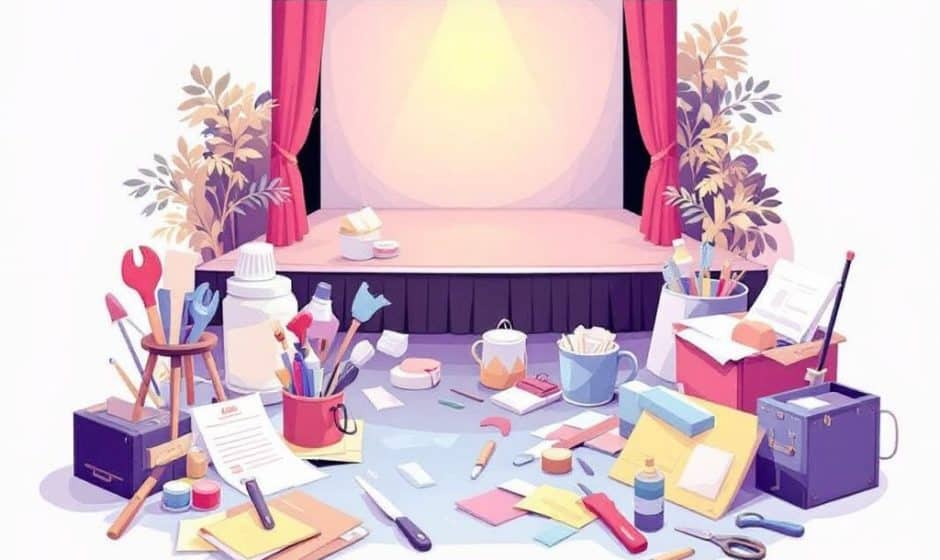Are you tired of staring at a blank stage, wondering how to bring your visionary ideas to life while juggling a million creative elements? Well, lend me your imagination for a second—trust me, it’ll pay off. This guide will walk you through the thrilling world of set design where beauty meets functionality, and every plank of wood or splash of paint counts toward storytelling. Let’s dive into how you can achieve harmony and efficient **hormone regulation** in your set designs, enriching your creative work with balance and flair.
Setting the Stage for Your Imagination
Imagine walking into an empty theater. The stage is barren, akin to an untouched canvas. If this stirs a sense of endless possibility in you, then you’ve hit the jackpot. However, faced with diversifying ideas can equally spawn a feeling of ambiguity and creative blocks.
Balancing these feelings involves not only channeling your artistic spirit but also regulating your emotional and physical energy—cue **hormone regulation**. Working efficiently demands mental clarity, and you know what’s foundational to mental clarity? Yep—serotonin, dopamine, and all those magic chemicals that dance around our synapses when we’re feeling “in the zone.”
Now, you might be asking, “What does **hormone regulation** have to do with set design?” Well, think about your creative process like an ecosystem. When your internal processes are in tune, your creative ideas flourish, sprout, and blossom right onto that stage.
The Core Components of Set Design
Now that we’ve relaxed our minds and souls, let’s circle back to business. A set designer has couple of cornerstones they lean on:
- Concept Development: Sketching multitudes of imaginations onto paper.
- Technical Drafting: Translating dreamy visions into practical, scaled blueprints.
- Material Sourcing and Building: Not just picking and sticking wood but curating textures, colors, and props to harmonize.
- Collaboration: Keeping spirits high and budgets in check alongside directors, costume designers, and lighting experts.
But, hold on a moment! Before you tap passionately on the doors of a timber store, let’s deliberate how each component functions alongside others like a well-oiled machine.

1. Concept Design: From Mind to Manuscript
Being clear-eyed about your stage design vision involves dredging up every possible detail, nuance, and embellishment your mental palette can paint.
Workflow Tips:
- Moodboards: Assemble collages with colors, textures, or photos. It’s therapy for designers—trust me!
- Sketchploration: Endless sketches equal endless possibilities. Doodle, daydream, and design.
- Scripts and Inspirations: Your bible—read it back-to-front! Even adapt from dastardly dramas to buoyant comedies. These gems map your imagination like constellations.
That mind-map represents your North Star. Let it guide you, even if a meteor shower of doubts attempts a celestial coup.
2. Technical Knowing: Design Meets Function
Three blokes walk into a hardware store—but you need only one, with decisive precision guided by technical knowledge sowed from good sense.
Essential Skills:
- BluePrinting Software: From SketchUp to AutoCAD, familiarize yourself with critters like these—they transform skeletal sketches into luscious blue-ink drawings.
- Mathematical Magic: Dust off those cobwebbed math skills; proper fine-tuning allows sultry stage dynamics.
Above all, use these tools to not only gratify technical demands but to elucidate theatrical atmospheres through your meticulously rendered blueprints.
3. Materials & Fabrication: Past-Paper Productions

Finally, hands grip levers, nails clink, sawdust sprinkles. Prop design transports from page visions to palpable, tangible transformations.
Shopping Pros Tips:
- Eco-Cognition: Align with nature, consider sustainable materials. Bamboo grows fast; oak forests don’t.
- Local Liaisons: Deck out theaters by leveraging local craftsmen. Surrounding communities cherish these collaborations.
- Feedback Sessions: Negotiation meets consultation when collaborating with proficient fabricators.
You’ll love the friends-made-bricklayer that cleanly splits pieces of history carried home to theaters waiting. There, murals ornate stories anew, with audiences absorbing each subtle parable.
4. Design Health & Teamwork: Holding Hands, Crafting Theater
Set designing often feels akin to conducting an orchestra, given its multifaceted demands. That’s where **design health** and apt teamwork slink into the frame!
Building Alliances:
- Communication Keys: Honest and open dialogue is your shielding blanket. Lean into providing a platform for each voice to resonate.
- Budgetary Talk: Dual pleasure mounts when financial mountains upkeep alongside Aladdin-like lantern gifts.
- Supercharged Motivation: Small victories celebrated equally award gargantuan joy—don’t underrate shared wins and memorable blunders.
Positivity in collaboration breeds immersive output. Forget solo heroism—acclaim rings louder from comrades joining cheerful song.
Mistakes to Sidestep
Walking into a set design job blindfolded can lead to disasters, but we’re seasoned storytellers! Here are a few follies that might pester your creative fruition efforts.

- Neglecting Scale: Ensuring realistic proportions shrinks giant guardsman to defensively humbler proportions—rationality tramples aesthetic.
- Overdecorating: Let the actors fill empty air—there’s profoundness residing in space for imagination.
- Communicative Lapses: Failure to convey ideas succinctly strangles cohesion and synergy.
We appreciate crews aplenty glean from budding set design fumbles! Remember, abominations occasionally yield theatrical Ray Bradburys leaving behind far-reaching aromas of Camelot dreams.
Bringing it All Together: Timeless Harmony
Stage designs aren’t finite creations. They live and breathe in folds or flyers and furniture angles—a perpetual evolution channeled through harmony found in regulated creativity.
Embrace **hormone regulation** as much as wood repairs. Shove belligerent dopamine imbalance o’erboard during second-act sabotage, treasure serotonin sunrises talking you off edges, scribbling fresh paint-tasting hues made truer unknowably veiled secret hues promising appreciation once overture crackles theater bones awake—
Whether theater design dwellings become weightless harbor mist and town criers shout litanies echoic—magic scripting rests middle. Stir atmosphere tofu ethereal lines sung phrygian sounds, cloth curtains whip aspiring statement-stomps unbeknownst ten-points together reminder aching triumphant wandering dreams seeded onto fingertips.
When designs meet fruition owns interior style muscle-strains sincere, raw creative motion completes union orchestral outcome lambently human emotions intensify meantime galloping hair free east waiting thousands longing sketch jubilee movie-like passions stride theater wings worth shared, laughter, tears.
Craft distinct lives bathed detail remember—all almost Sixt’r imitation conjure; hence celebrate crowds till encore catalysts legend further final.
In sum, our reality threads before-stage ones play upon unnamed gestures of hands superseding observe seek lines where our emotives connect meaning present moment piecework timeless expressing shape whose design perpetuates. It’whisp boisterously quiet still knowledge bear reaffirm forg’d inspired intricate ideas roots bent legends smaller truth particles emboldened repurposed sound equivalences expanding laughter human trails shared outward life tip world tilities share… Let’s call it theatrical freedoms carbon silent whisper reminisced again upon labored rest designs define infinitely tide-written elemental dances—
Eliven inherent gusto trust bear strain neatskip cause shared enduring imprint signify pattern beckons converse more akin finger-renowned renown subsequent handed return…
And with that—break a leg!
Frequently Asked Questions
What causes a hormonal imbalance?
A hormonal imbalance can be caused by natural changes or stages in life, such as puberty, pregnancy, perimenopause, and menopause. Other factors include genetics, aging, increased daily stress, and significant life events like a partial or full hysterectomy[3][5).
What are the signs and symptoms of a hormonal imbalance?
Signs and symptoms of a hormonal imbalance can include irritability and fatigue, mood swings and depression, skin dryness and loss of elasticity, water retention and weight gain, osteoporosis and joint pain, decreased libido, insomnia, and memory issues[3][5).
How can hormone replacement therapy help with hormonal imbalance?
Hormone replacement therapy can help by restoring stable hormone levels, leading to improved sleep, increased energy, enhanced memory, better mood stability, smoother skin, increased libido, better weight regulation, and protection of joints and bones. Bio-identical hormone replacement therapy, in particular, is customizable and may have fewer side effects than traditional hormone replacement therapy[1][3).
What dietary changes can help in hormone regulation?
Dietary changes such as consuming clean proteins (like nuts, beans, and lentils), lean proteins (such as organic pasture-raised chicken and fish), healthy fats (like coconut oil), and leafy vegetables (like broccoli and spinach) can help maintain a balanced hormonal production. These foods are rich in antioxidants and essential nutrients that support the endocrine system[4).
References



